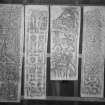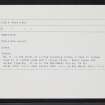Scheduled Maintenance
Please be advised that this website will undergo scheduled maintenance on the following dates: •
Tuesday 3rd December 11:00-15:00
During these times, some services may be temporarily unavailable. We apologise for any inconvenience this may cause.
Monifieth
Cross (10th Century)
Site Name Monifieth
Classification Cross (10th Century)
Alternative Name(s) Monifieth, St Regulus' Church
Canmore ID 33411
Site Number NO43SE 25.04
NGR NO 4953 3235
Datum OSGB36 - NGR
Permalink http://canmore.org.uk/site/33411
- Council Angus
- Parish Monifieth (Angus)
- Former Region Tayside
- Former District City Of Dundee
- Former County Angus
Monifieth 4 (St Regulus), Angus, cross-shaft fragment
Measurements: H 1.17m, W 0.28m, D 0.18m
Stone type: sandstone
Place of discovery: NO 4953 3235
Present location: National Museums Scotland (X.IB.25)
Evidence for discovery: found re-used as a lintel over a door of the medieval church, and after its demolition in 1812 it was re-used again in the new church. It was given to NMAS in 1871.
Present condition: broken or trimmed top and bottom and weathered.
Description
This fragment appears to represent the entire length of the shaft of a free-standing cross, though missing its basal tenon. It was thus a small and slender cross, carved in relief on all four faces, and it had circular armpits. It is edged by a fat roll moulding, and face A is divided into four panels by horizontal roll mouldings. The top panel clearly extended into the cross-head, because it depicts the lower part of a crucifixion scene, with the figure of Christ from below the waist and dressed in a short tunic, with a frontal figure on either side. All three pairs of feet stand on the lower frame. In the panel below stand two frontal clerics in long robes, each holding an object in his right hand and each with his feet on the lower frame. Below again are two frontal figures in short tunics, each holding a curved object, possibly a horn, in his right hand and each with his feet on the lower frame. The basal panel depicts a profile figure seated on a chair and playing a large triangular harp.
Face C is carved with four roundels of interlinked circular interlace and has at the base a supine quadruped with its head turned back over its body.
There is a single panel of interlace on each of the narrow faces B and D, with a quadruped placed vertically and crouched at the base of B and another placed horizontally with its head turned back at the base of D.
The sculptor has added an inner incised line to Christ’s tunic and here and there to the bodies of the animals.
Date range: tenth century.
Primary references: Neish 1872, 72; ECMS pt 3, 265.
Desk-based information compiled by A Ritchie 2018.
NO43SE 25.4 4953 3235.
No. 4 is the shaft of a free-standing cross, 3 feet 10 inches high by 11 inches wide and 7 inches thick. Bears human and animal figures. It is in the RMS(NMAS) Acc.no. IB 25.
J R Allen and J Anderson 1903; J Stuart 1867; J Neish 1873.
















